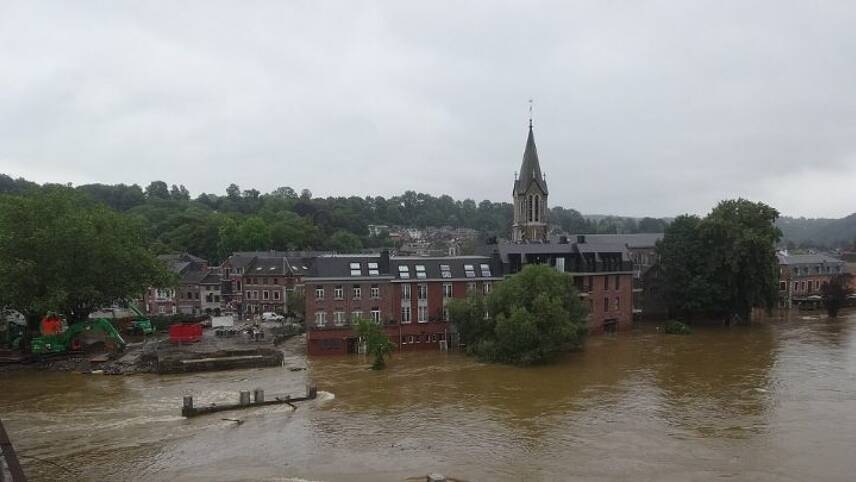Register for free and continue reading
Join our growing army of changemakers and get unlimited access to our premium content

Pictured: Flooding in western Germany this summer. Image: Regine Fabri
Published today (31 October) to coincide with the ceremonial opening of COP26 in Glasgow, the ‘State of the Global Climate’ report contains data collected through to the end of September 2021. It details this year’s major extreme weather events and also provides an historic look at indicators including temperatures, ocean heat, ocean acidity levels, sea-level rise and ice melt. The socio-economic impacts of these trends are also stipulated.
A headline finding is that the past seven years have been the warmest on record. While 2021 has been cooler than the other years since 2015, the report states that this is a blip “due to the influence moderate La Niña at the start of the year” rather than a sign that temperatures will fall in the coming years. La Niña events happen periodically, around every three years, and entail the cooling of ocean surface temperatures in the Pacific.
The world is currently, the report states, 1.09C warmer than in pre-industrial times. This figure will be updated for the WMO’s finalised report at the end of the year. Other scientific reports in recent months have broadly reached the same conclusion, warning that this will likely put the world on course to breach the Paris Agreement’s commitment to limit the global temperature increase to 1.5C by 2100, by the 2030s.
Also detailed in the report is a timeline of the extreme weather events that have swept large portions of the globe, causing hundreds of deaths, impacting hundreds of thousands of livelihoods and having knock-on impacts on public health and the economy.
The report recaps “exceptional” heatwaves that affected northern and western regions in North America during June and July, with many towns and cities breaking record high temperatures by up to 6C. There were also multiple heatwaves in California, with temperatures in Death Valley hitting 54.4C on 9 July. At the same time, California suffered its worst single fire on record – the Dixie wildfire, which has burned more than 390,000 hectares over a three-month period.
Here in Europe, extreme heat also killed hundreds. Sicily reached 48.8C on 11 August – a provisional record high for Europe. Madrid had its hottest day on record three days later, with temperatures of 42.7C recorded. Wildfires swept Turkey, Algeria and Greece, with the full impact yet to be quantified.
While some parts of the world sweltered and burned, others grappled with extreme rainfall. Flash floods in the Henan Province, China, in late July, caused 302 deaths and economic losses of $17.7bn. More than 200 died in flooding in western Germany and bordering nations in July, at the same time. Some parts of South America and Africa experienced persistent rainfall resulting in widespread flooding, while other regions experienced drought. Madagascar, for example, is currently in the grips of a malnutrition crisis due to drought. Globally, a 19% increase in the number of people suffering from food crises was recorded on 2019 levels.
And, of course, before the summer, many places experienced abnormally cold conditions. Texas experienced its lowest temperatures in more than 40 years in February, for example.
Preliminary studies into the link between these events and the global temperature increase have been completed in many cases. The report states that the heatwaves in North America this summer “would have been virtually impossible without climate change”. The flooding in western Europe “had been made more likely by climate change”, by a factor of up to seven.
Today’s report will be showcased at the Science Pavillion at COP26 and will be used to inform negotiations. Other recent reports to have been given this level of status include those from the UK Met Office, the International Panel on Climate Change’s (IPCC) Working Group 1 and the International Energy Agency (IEA).
“From the ocean depths to mountain tops, from melting glaciers to relentless extreme weather events, ecosystems and communities around the globe are being devastated,” said UN Secretary-General António Guterres.
“COP26 must be a turning point for people and planet.
“Scientists are clear on the facts. Now leaders need to be just as clear in their actions. The door is open; the solutions are there. COP26 must be a turning point. We must act now – with ambition and solidarity – to safeguard our future and save humanity.”
Spotlight on oceans
Much of the report is dedicated to the impact which the global temperature increase is having on ocean systems, and how this, in turn, is limiting the capability of oceans, ice sheets and glaciers to provide carbon sequestration and climate adaptations now and in the future.
Notably, around 90% of the Earth’s accumulated heat is stored in the ocean, and the ocean absorbs around 23% of the annually-produced CO2. But these proportions are likely to fall.
The ocean heat content of the upper 2000m depth of the ocean reached a record high in 2019 and, it has now been confirmed that 2020 exceeded that record. The WMA is expecting more warming in the coming decades, after a sharp increase since 2000. Much of the ocean experienced at least one ‘strong’ Marine Heatwave at some point in 2021, the report states.
At the same time, the ocean’s acidity levels are changing more rapidly than they have for at least 26,000 years. As the pH of the ocean decreases, its capacity to absorb CO2 decreases in turn.
These trends have led to a doubling of the factor of sea-level rise between 1993 and 2002, and 2013 and 2021. Also, record lows for sea ice levels were recording in the Arctic this July.
Sarah George


Please login or Register to leave a comment.